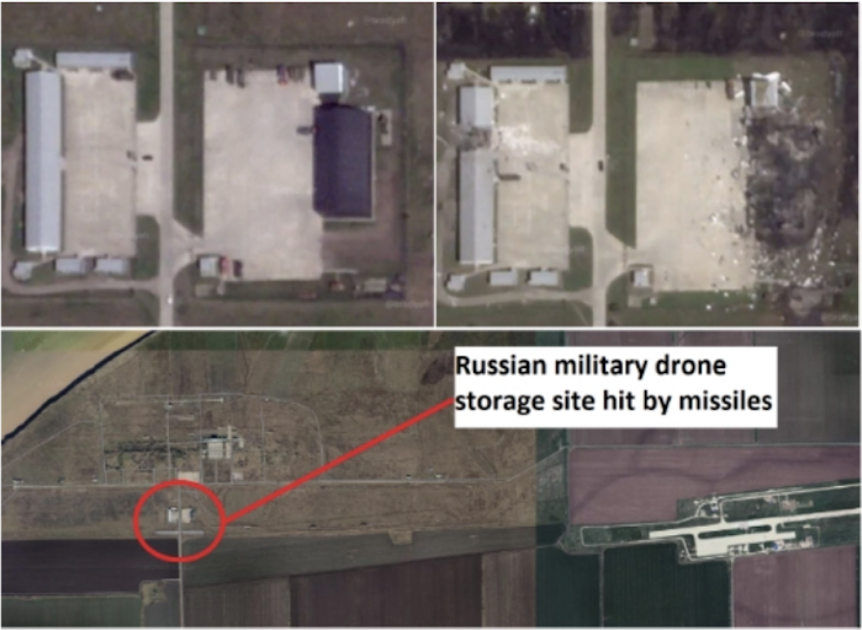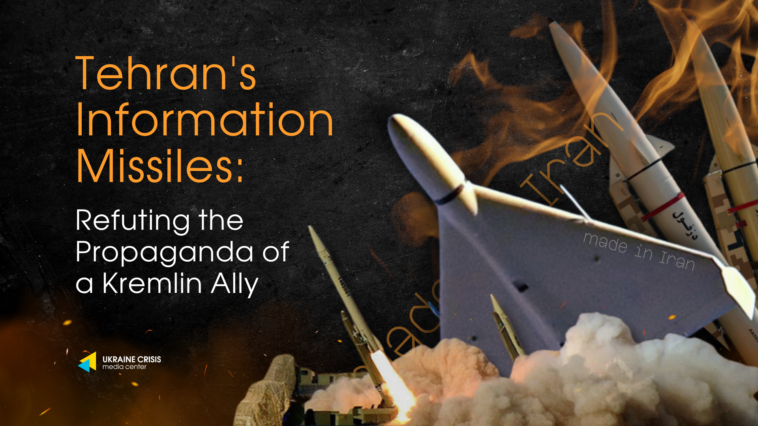Matt Wickham & Volodymyr Solovian
The saga of Iran’s missile deliveries to Russia, which began in spring 2022, has reached a critical point. In early September, The Wall Street Journal reported that Iran had supplied Russia with short-range ballistic missiles.
Reports from the press indicate that Russia plans to deploy hundreds of Fath-360 ballistic missiles against Ukraine in the near future. These missiles have a range of 80 to 120 kilometers and a 150 kg warhead.
In terms of parameters, the Fath-360 is very similar to the HIMARS missiles, a system that once changed the course of the war in favor of the Ukrainian Armed Forces. Russia could use Iranian ballistic missiles to replace Iskanders and S-300 strike modifications, thereby expanding the number of targets the occupiers can hit in Ukraine’s rear.
While Kyiv’s Western allies consider how to respond to the next stage in the strengthening of the Moscow-Tehran alliance, the Iranian regime launches its own information campaign to conceal the supply of weapons for the war against Ukraine.
In this analysis, we will examine the narratives used by the Ayatollahs’ regime, using the article “Missile Claims” from the pro-government Tehran Times as an example.
First, let’s delve into some details about the Tehran Times.
The newspaper positions itself as the voice of the people; however, the publication is actually owned by the Islamic Development Organisation (IDO), which oversees religious and cultural policy in the state. Moreover, the organization is subordinate to Iran’s Supreme Leader, Ali Khamenei.
Clearly, the Tehran Times relays the government’s narratives. For example, it regularly and complementarily covers the operations of the Islamic Revolutionary Guard Corps (IRGC), a designated a terrorist organisation in several Western countries, including the US.
The significance of the IRGC lies in its indirect involvement in Russia’s aggression against Ukraine, as it operates military drones provided by Iran for the Russian army.
The article ‘“Missile Claims” reveals the author’s bias against Ukraine from its very first sentences. According to Tehran Times journalist Soheila Zarfam, “the West is left to look for someone to blame for the lost war in Ukraine, so its eyes have once again turned to Iran”.
This thesis reflects Tehran’s primary goal in the information field: to deny any involvement in supporting Russian aggression and shift blame to the West.
The Hybrid Warfare Analytical Group refutes the Tehran Times’ key manipulative narratives...
1. “Iran has never and will not send missiles or drones to Ukraine; we want peace”
According to the article ‘Missile Claims,’ Western media claim that hundreds of Iranian missiles have been transferred to Russia but have failed to confirm similar allegations about drones.
Ukraine’s effective air defense made operating Russian jets in its airspace a suicide mission from the outset of the full-scale invasion. In response, by summer 2022, Russia sought cheaper ways to terrorize Ukraine’s rear, turning to Iran, which—despite sanctions—produced military UAVs in sufficient numbers to meet Moscow’s needs.
Unfortunately, the aggressor country made a favorable decision with the relatively inexpensive Shahed-136, and now these drones are an essential component of missile and drone strikes against Ukraine.
According to the US Institute of Peace, Iran alone will have supplied over 1,700 kamikaze drones by December 2022. In early 2023, Moscow announced plans to manufacture approximately 6,000 drones under Iranian license at a plant in Elabuga, Tatarstan, by the summer of 2025.
Given the current level of use of Shahed-Gharanei (800 units were launched into Ukrainian airspace in August 2024), it is reasonable to expect that, in addition to production in Russia, direct supplies of drones and components from Iran will continue.
In addition to Shahed products, since 2022, the Russians have been using a fairly wide range of Iranian reconnaissance drones. For example, the Qods Yasir UAV was identified thanks to a video released by the Russians, which clearly shows a distinctive ‘float’.
Another example is the Mohajer-6 reconnaissance and strike UAV.
The words about the ‘unproven’ accusations of the Iranian origin of the drones are a phantom of the official rhetoric of Tehran and Moscow. For some time, the Iranian authorities have attempted to cover their tracks by downplaying their role in providing military assistance to Russia.
For example, back in November 2022, former Iranian Foreign Minister Hossein Amir-Abdollahian stated that a ‘small number’ of drones had been delivered to Russia a few months before the full-scale invasion.
However, the facts show the opposite: the first use of Iranian drones against Ukarina took place only after reports of Russia’s purchase of the first batches of Shahed-136.
It is significant that today Iranian officials no longer consider it necessary to keep a good face for a bad game. For example, on September 9, 2024, Ahmed Bahshaish Ardestani, a member of the Iranian Parliament’s National Security and Foreign Policy Commission, confirmed in an interview with Iran Watch that his country was sending drones to Russia.
2. “Iranian instructors did not train Russian soldiers in Ukraine”
The author of the article ‘Missile Claims writes: ‘Former US Special Envoy for Iran Robert Malley even claimed that Iran had military personnel stationed in Ukraine to assist the Russians in using drones. Evidence has never supported these large claims.
The Iranian side frequently denies information from official Ukrainian and Western sources. However, publicly available evidence, such as photos or videos of Iranian instructors at Russian military facilities, cannot support the argument in this case. The Iranian specialists conducted their mission in strict secrecy. Naturally, Ukraine’s intelligence services and Western partners own the relevant evidence base, and they only permit disclosure if it does not jeopardize the information sources.
It is worth noting that in October 2022, the US National Security Council announced that it had evidence of Iranian instructors in Crimea. Subsequently, in February 2023, the Ukrainian General Staff confirmed the presence of Iranian instructors in Luhansk to train Russian military personnel on the use of Shahed drones.
This summer, Ukrainian drones also attacked the 726th Air Defence Training Centre in Russia’s Krasnodar Territory. According to the Kyiv Post, the strike targeted a barracks housing Iranian instructors.

Also in August 2024, the Security Service of Ukraine (SBU) announced that it had gathered evidence against IRGC Brigadier General Sharifi Molasarei Abbas Moussa, who directly assisted the occupiers in conducting air strikes against Ukraine with Iranian UAVs. According to the investigation, the general made a personal visit to Crimea in 2022.
‘Under his leadership, the specialized units of the Russian Armed Forces were trained on the combat use of the drones received at the peninsula’s training grounds,’ the SBU stated.
3. “Double standards: Why can the West supply weapons to Ukraine but not Iran?
The Tehran Times journalist employs the false equivalence technique, which compares the aggressor and the victim. In fact, the West is arming Ukraine with precision weapons to defend itself against Russia’s illegal invasion, which seeks to devastate the Ukrainian state.
Iran supplies weapons to the former metropolis, feeding its neo-imperial appetites. The Shahed UAVs are used as terror weapons, causing suffering among the Ukrainian people, particularly during the winter, when such attacks deprive civilians of heat and light.
The key distinction is between intentions and consequences: the West is assisting Ukraine in defending itself, whereas Iran is supporting Russia’s terrorist campaign, exacerbating the humanitarian crisis and facilitating war crimes.
Supporting a country’s defense against an illegal invasion should not be confused with assisting an aggressor seeking to destroy a neighboring state.
4. “Why is trade between two sovereign nations of concern to the West?”
Tehran and Moscow’s efforts to disguise the exchange of military technology as ‘trade’ appear extremely unconvincing.
It is worth noting that the Kremlin boasts of its military technology cooperation with Iran. For example, Kremlin spokesman Dmitry Peskov recently stated that ‘Russia is developing cooperation with Iran in various areas, including the most sensitive, and our country will continue to do so for the sake of a better life for people.’
Western countries rightfully condemn and oppose Moscow-Tehran military-technical cooperation (in the form of sanctions) because it threatens the global security system.
Russian Su-35 fighter jet in Iranian Air Force camouflage, January 2024. According to experts, the contract between Moscow and Tehran may include barter— planes and helicopters (Mi-28)—in exchange for Shahed-131 and Shahed-136 drones, as well as ammunition for the Russian army.
Russia is assisting Iran with missile technology (particularly engines). Soon, the Russian missile modifications could end up in the hands of Iranian proxies in the Middle East, who regularly attack Western trade routes.
After all, Iranian missiles occasionally strike US military facilities in the region.
Deliveries of Iranian UAVs and ballistic missiles could spark a war that extends beyond Ukraine and Russia. According to recent reports on the Shaheds’ routes, an Iranian drone carrying a live charge crossed into Latvian territory.
Due to their long range, these drones can be used to stage provocations in NATO countries’ deep rear.


